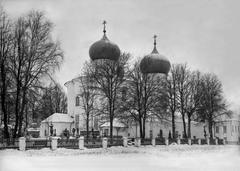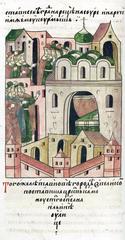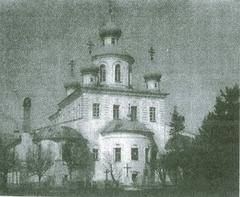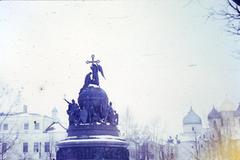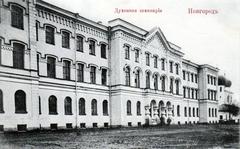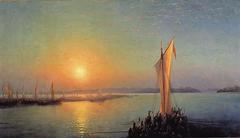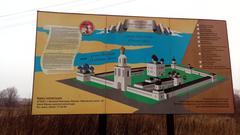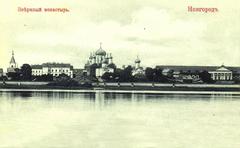Comprehensive Guide to Visiting Victory Monument, Veliky Novgorod, Russia
Date: 24/07/2024
Introduction
The Victory Monument in Veliky Novgorod, known as the Монумент Победы, is a revered symbol commemorating the Soviet Union’s triumph over Nazi Germany during World War II. Erected on January 20, 1974, to mark the 30th anniversary of Novgorod’s liberation from Nazi occupation, the monument stands as a testament to the city’s endurance through a challenging period in history (Wikipedia).
Situated on Catherine’s Hill in the southern part of Kremlin Park, the monument’s central figure is a bronze sculpture of a rearing horse with a Soviet warrior, designed by sculptors G.V. Neroda and A. Filippova, and architects A. Dushkin and A. Saikovsky. This powerful imagery symbolizes the defeat of fascism, with the horse trampling a crushed swastika beneath its hooves (Wikipedia). The monument also features a brick tower adorned with bas-reliefs depicting key stages of the Great Patriotic War, further solidifying its historical and cultural significance.
This comprehensive guide aims to provide visitors with detailed information on the Victory Monument, including its historical background, architectural features, visitor information, and travel tips. Whether you’re a history enthusiast, a student, or a traveler, this guide will help you make the most of your visit to this iconic landmark.
Table of Contents
- Introduction
- Historical Background
- Visitor Information
- Accessibility and Current Condition
- Special Events and Guided Tours
- Cultural and Historical Significance
- Representation in Currency
- FAQ
- Conclusion
Historical Background
Origins and Construction
The Монумент Победы (Victory Monument) is located on Catherine’s Hill in the southern part of the Kremlin Park. Its construction was sanctioned by the Council of Ministers of the Russian Soviet Federative Socialist Republic (RSFSR) on January 5, 1968, and was completed between 1973 and 1974. The monument was officially unveiled on January 20, 1974, coinciding with the 30th anniversary of Novgorod’s liberation from Nazi occupation (Wikipedia).
Design and Symbolism
Designed by sculptors G.V. Neroda and A. Filippova, along with architects A. Dushkin and A. Saikovsky, the central figure of the monument is a bronze sculpture of a rearing horse with a rider, symbolizing a Soviet warrior. The rider holds a raised sword in his right hand, while his left hand is extended forward and downward with an open palm. Beneath the horse lies a crushed and twisted swastika, representing the defeat of fascism. The combined weight of the horse and rider is 27 tons, and the sculpture stands 8 meters tall. It is mounted on a massive pedestal, which itself rests on a granite platform measuring 3 meters in height and covering an area of 120 square meters (Wikipedia).
The Tower and Its Features
Behind the sculpture is a monumental brick tower, 23.5 meters high with a base measuring 6.5 by 8.5 meters. At the top of the tower is a boat adorned with ancient military attributes such as shields and spears. The tower’s walls feature four large bas-reliefs that depict key stages of the Great Patriotic War and the victorious battles of the Red Army for the liberation of Novgorod. The total height of the tower, including the boat, is 34.5 meters (Wikipedia).
Visitor Information
Visiting Hours and Tickets
The Victory Monument is accessible to the public year-round, although specific visiting hours may vary. It is advisable to check the latest information on official websites or local tourist information centers prior to your visit. Currently, there is no admission fee to visit the monument.
Travel Tips and Nearby Attractions
Located in the Kremlin Park, the Victory Monument is easily accessible by public transport or on foot from the city center. Nearby attractions include the Novgorod Kremlin, the Cathedral of St. Sophia, and the Museum of Wooden Architecture. Combining your visit to the monument with these sites can provide a comprehensive historical experience.
Accessibility and Current Condition
The tower originally featured a spiral staircase leading to an observation balcony with views of the Volkhov River, the rowing canal, Lake Ilmen, and the Kremlin. However, access to the tower is currently restricted due to its deteriorating condition. The granite pedestal beneath the sculpture also contains interior spaces, which are similarly closed to the public (Wikipedia).
Special Events and Guided Tours
The Victory Monument serves as a focal point for various commemorative events, especially during Victory Day celebrations. Guided tours are available from local tour operators, providing in-depth historical context and insights into the monument’s significance.
Cultural and Historical Significance
The Victory Monument is not just a tribute to the Soviet victory in World War II but also a representation of the resilience and strength of the Soviet state and its people. According to G.V. Neroda, one of the monument’s creators, it embodies the great power of the Soviet state and the heroic deeds of its people during the war against Nazi Germany (Wikipedia).
Representation in Currency
The Victory Monument is also featured on the 1997 series of the five-ruble banknote issued by the Bank of Russia, further cementing its status as an iconic symbol of Veliky Novgorod and its historical significance (Wikipedia).
FAQ
What are the visiting hours for the Victory Monument?
The monument is accessible year-round, but specific visiting hours may vary. It is best to check the latest information from official sources.
How much are tickets to the Victory Monument?
Currently, there is no admission fee to visit the Victory Monument.
Are there guided tours available?
Yes, guided tours are available from local tour operators, providing in-depth historical context and insights into the monument’s significance.
Conclusion
The Victory Monument in Veliky Novgorod stands as a testament to the city’s historical resilience and the Soviet Union’s triumph in World War II. Its intricate design, symbolic elements, and historical significance make it a must-visit landmark for those interested in Russian history and culture. Despite the challenges it has faced over the years, the monument remains a powerful reminder of the past and a symbol of enduring strength and victory.
For more updates and travel tips, download our mobile app Audiala or follow us on social media.
References
- Wikipedia contributors. (n.d.). Монумент Победы (Великий Новгород). Retrieved from Wikipedia
- Novgorod Travel. (n.d.). The Route of Memory for the 70th Anniversary of Victory in the Great Patriotic War. Retrieved from Novgorod Travel
- Guide to Petersburg. (n.d.). Major Sightseeings of Veliky Novgorod. Retrieved from Guide to Petersburg
